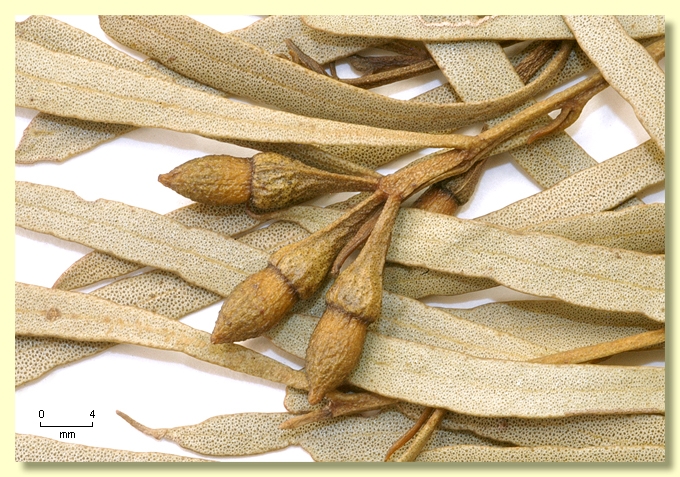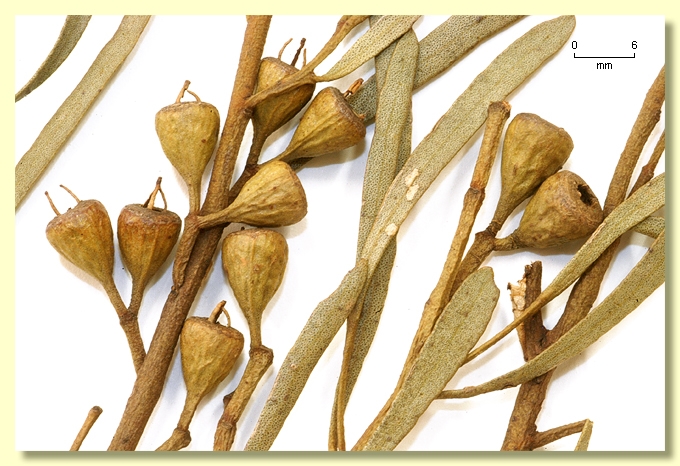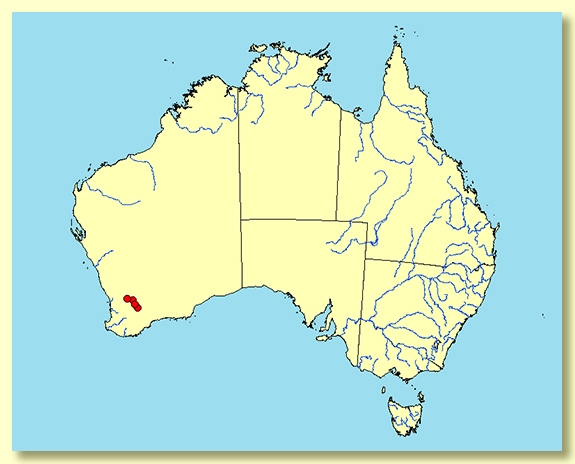Euclid - Online edition
Eucalyptus spathulata subsp. salina
Eucalyptus | Symphyomyrtus | Bisectae | Glandulosae | Erectae | Abundae
Mallet to 10 m tall, with a dense fine crown. Lignotuber absent.
Bark smooth, satin-like throughout, silvery grey over coppery, pink and bronze.
Branchlets have oil glands in the pith.
Juvenile growth (coppice or field seedlings to 50 cm): stems rounded in cross-section; juvenile leaves sessile to shortly petiolate, alternate, linear, 3.5–5 cm long, 0.3–0.5 cm wide, margin entire or irregularly indented, apex rounded or pointed.
Adult leaves alternate, petioles 0.1-0.4(0.7) cm long; blade linear, 4.2-8.2 cm long, 0.3–0.7 cm wide, base tapering, margin entire or irregularly indented, apex blunt, concolorous, glossy, green, the surface appearing "glazed", midrib usually visible but all other venation obscured by numerous rounded oil glands.
Inflorescence axillary unbranched, peduncles 0.3–1.5 cm long, spreading to erect; buds 3 or 7, pedicellate (pedicels 0.2–0.6 cm long). Mature buds ovoid to fusiform (0.9-1.0 cm long, 0.4 cm wide), the hypanthium wider than the operculum, scar present (outer operculum lost early), inner operculum ca 2–3 times the length of the hypanthium, horn shaped to long-conical and sometimes minutely warty, all stamens erect, anthers oblong, versatile, dorsifixed, dehiscing by longitudinal slits, style long and straight, stigma blunt or slightly dilated, locules 3 or 4, the placentae each with 4 vertical rows of ovules. Flowers white.
Fruit pedicellate (pedicels 0.2–0.6 cm long), cupular to obconical, 0.6–0.8 cm long, 0.6–0.7 cm wide, disc level then descending to ovary roof, valves 3 or 4, at about rim level, sometimes with delicate style remains persisting.
Seeds brown, 0.8–2 mm long, ovoid to flattened-ovoid, dorsal surface clearly but shallowly reticulate, hilum ventral.
Cultivated seedlings (measured at node 10): cotyledons Y-shaped (bisected); stems rounded in cross-section, maybe slightly warty; leaves sessile to shortly petiolate, opposite for 2 or 3 nodes then alternate, linear, 5.5–9.5 cm long, 0.3–1 cm wide, green, dull until ca node 8 then becoming glossy, narrower; minutely warty on both surfaces but feel more or less smooth.
Flowering have been recorded in summer.
Eucalyptus spathulata is a low-branching mallet species endemic to Western Australia, found in the Tammin – Pingaring – Dumbleyung – Ongerup – Lake Grace area, usually on saline sites. The bark is smooth, sometimes glossy or satiny, the crown full, wide-spreading with adult leaves conspicuously linear, glossy (glazed), olive green to bluish green with a glazed surface. Buds are small and stamens in the unopened bud are fully erect.
In 2005 Nicolle & Brooker described Eucalyptus spathulata subsp. salina, a mallet restricted to the catchment of the Salt River in the Quairading to Pingaring area. According to Nicolle & Brooker the two subspecies of E. spathulata can be distinguished as follows:
E. spathulata subsp. spathulata
Adult leaves bluish green, 0.2–0.5 cm wide; buds seven per umbel; fruit 0.4–0.7 cm long, 0.5–0.6 cm wide. Occupies the southern part of the distribution of the species, from Lake Grace and Newdegate to Ongerup and Wagin, largely in the catchments of the Pallinup and Blackwood Rivers.
E. spathulata subsp. salina
Adult leaves green, 0.3-0.7 cm wide; buds three or seven per umbel; fruit 0.6-0.8 cm long, 0.6-0.7 cm wide. Occupies the northern part of the distribution of the species, found around Salt River in the Quairading to Pingaring area.
Eucalyptus spathulata belongs in Eucalyptus subgenus Symphyomyrtus section Bisectae subsection Glandulosae because the buds have an operculum scar, cotyledons are bisected and branchlets have oil glands in the pith. Within this large subsection (ca 80 species) E. spathulata is closely related to a group of mallees and mallets (series Erectae subseries Abundae) recognised by the glazed leaf surface, leaves with a great density of oil glands that obscures the venation, peduncles long and flattened, inflorescences spreading and buds with a long operculum and fully erect stamens.
E. spathulata is distinguished from its near relatives by the small, scarcely ridged buds and fruit, long-conical operculum much longer than the base of the bud, mallet habit and linear-leaved crown. Within its area of distribution it is most likely to be confused with two mallee species, E. orthostemon and E. vegrandis.
Eucalyptus orthostemon, a recently described mallee taxon found in the wheatbelt north from Cranbrook to near Wongan Hills and Moora, is closely related to the mallet E. spathulata and differs from it only in the presence of multiple stems arising from a lignotuber.
Eucalyptus vegrandis has similar leaves and bud shape to E. spathulata but always has at least the innermost stamens inflexed in unopened buds. E. spathulata has bud clusters of threes and sevens; E. vegrandis has clusters of sevens. To correctly identify very narrow linear-leaved specimens where reliable habit information is lacking, dissection of buds is necessary to see if the stamens are all erect or some are inflexed. If inflexed then the specimen cannot be E. spathulata but is probably E. vegrandis. If stamens are all erect and the habitat is known to be low lying and slightly saline then it is likely to be E. spathulata if a mallet or, if a mallee, then E. orthostemon.
Eucalyptus spathulata: Latin spathulatus, spathulate or spatula-shaped, allusion obscure, certainly not the leaves.
subsp. salinafrom Latin salinus, referring to salt, i.e. from the saline habitat and geographic name Salt River.








